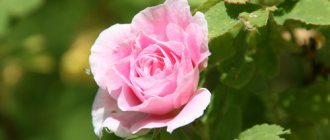Plants planted in public gardens, city gardens and other public places, although they please more people, receive much less care and attention than their relatives from private lands. At the same time, they adequately cope with their decorative role. Among them is the park rose - an unpretentious shrub with flowers of amazing beauty.
Park rose - what is it?
The beauty of this flower has been glorified by poets and appreciated by aesthetes since time immemorial. It is amazing to see large, strong bushes strewn with flowers that calmly tolerate both drought and severe frosts. Few people know that the park rose is, in fact, a cultivated variety of rose hips, which explains the lack of special care procedures. The breeders did a great job, enhancing the decorative properties of the plant while maintaining its vitality.
What does a park rose look like?
The ornamental shrub of the improved rosehip can reach one and a half meters in size. Such tall park roses can only be found in especially favorable conditions for them, but the average height of the plant fluctuates around a considerable mark of 1 m. The shrub looks strong and lush, boasts abundant flowering, and it begins already at the beginning of summer and lasts about a month.
At this time, the park rose simply enchants with its charm. It is covered with double scale-like flowers, in which you can count at least a hundred petals. At the same time, the possible color range of this plant is strikingly diverse: from light cream to rich purple, including soft pink, bright red and even sunny yellow buds. In addition, during the flowering period, the park rose is surrounded by a subtle, pleasant aroma, which makes it even more attractive.
Characteristics of crop species and varieties, what they look like
Currently, there are a large number of varieties. They differ from each other in size, flower color, and flowering duration.
Floribunda
Park rose: planting and care in open ground
Today, floribunda rose is one of the popular varieties. The plants are frost-resistant, unpretentious, resistant to diseases and pests, bloom from the beginning of summer until the first cold weather.
Remy Martin
The park rose Remy Martin was bred in France in 1995. The perennial plant is a tall bush with branched, thornless shoots and dense, dark green foliage.
At the beginning of summer, the bush is covered with pointed buds with tightly fitting petals. As they bloom, they transform into double flowers with a diameter of 6-8 cm. The color of the inflorescences is copper-golden with an apricot tint. During the wilting period, the outermost flower petals turn pink.
Inflorescences can be single or collected in brushes of 3-5 pieces. Flowering is long and lasting. As the buds open, a soft, pleasant, unobtrusive aroma appears in the air.
For reference! The variety is immune to fungal diseases; the petals do not fade in the open sun. The plant can withstand frosts down to -25 °C without shelter.
Double flowers up to 8 cm in size
Fluorescent
The variety has a powerful, spreading bush of regular shape. The plant blooms 2 times a season.
The first wave occurs in June, the plant blooms again in mid-July. During flowering, cup-shaped buds appear among the dark green, glossy foliage, which bloom to form double flowers of bright red color.
The inflorescences are collected in a brush of 3-5 pieces, thanks to this the flowering bush looks chic and festive.
Important! Fluorescent is a rose that does not need to be covered for the winter
Repeat-blooming variety
Rose hips
Rosehip or dog rose is a common plant that can be found within the city and in garden plots.
Thanks to the wide variety of varieties, you can create a beautiful flowering combination. Caring for rose hips is not difficult, so it is suitable even for an inexperienced gardener.
Louise Bugnet
Canadian species of park rose. The plant forms a compact bush one meter high. Flowering occurs in 2 stages: the first wave begins in June, the second at the end of July. The variety has a peculiarity - bright cherry buds appear at the beginning, and when they bloom, snow-white petals with a slight pistachio or purple tint appear.
Like all hybrids, the plant does not hold open flowers for a long time. After blooming, the flower lives for 2 days, then the petals fly off. It is replaced by new inflorescences, so the bush looks luxurious throughout the warm period. The aroma of the flower is not strong, but persistent.
The plant is compact, 1 meter high
Marchenland
The 1.5 meter high bush has straight shoots with large, frequently spaced thorns.
Among the large dark green foliage with a glossy surface, large semi-double flowers of a light pink hue with a delicate orange tint appear in early summer. Flowering is long and abundant.
Attention! The garden variety is resistant to diseases, covering is not required. For abundant flowering, the plant is planted in an open sunny place.
The plant is widely used to decorate the garden.
Musk hybrids
This species forms a powerful bush up to 4 meters high. At the beginning of summer, the plant is covered with large double flowers, 8 cm in diameter. The color of the inflorescences depends on the variety. For abundant flowering, it is important to plant the rose in an open, sunny place.
Elmshorn
The variety was bred in Germany in 1951. A tall, vigorous bush reaches 2 meters in height.
At the beginning of flowering, the inflorescences are painted a soft crimson color; as the petals bloom, they become dark pink. In hot weather, double flowers may fade.
Inflorescences are collected in a brush of 10-20 pieces. During flowering, the air is filled with a light nutmeg aroma with apple notes.
Important! The variety is resistant to diseases and, with proper care, can bloom again at the end of summer.
Flowers are collected in brushes of 10 pieces
Lichterlo
An erect bush, up to 80 cm high, densely covered with dark green leathery leaves. Flowering is abundant and long lasting. At the beginning of summer, the plant is covered with blood-red double flowers, 8 cm in size.
The variety is winter-hardy and unpretentious. For abundant flowering, the seedling is planted in an open sunny place, protected from northern winds. The rose is planted singly, in rose gardens and composition plantings. Cut flowers last a long time.
Flowers exude a delicate aroma
Shrubs
This shrub group appeared 50 years ago. There are tall, low and climbing varieties. Branched varieties require support. They are frost-resistant and rarely suffer from diseases. Flowering is lush and abundant, long lasting or repeated. Flowers exude a pleasant aroma.
Moden Fireglow
The Canadian rose forms a dense, erect bush 100 cm high. The variety has high winter hardiness and beautiful flower color. Rich orange-red semi-double flowers are collected in brushes of 3-5 pieces.
The first flowering is abundant; at the end of summer, single specimens appear on the bush. In autumn, after flowering, round, multi-seeded fruits are formed.
Important! The variety is highly resistant to powdery mildew and moderately resistant to black spot.
Salmon-red flowers exude a delicate aroma
Ghislaine de Feligonde
This variety is often used to create hedges and vertical gardening. The re-blooming shrub reaches up to 2 meters in height.
At the beginning of summer, the plant is covered with small peach-pink flowers, which change color to a lighter color as they bloom. In sunny weather, the petals fade and become white; in cold weather, the flower has a pale pink color.
All flowers change color unevenly, which makes the plant multi-colored.
The plant is disease resistant
Explorer Series
This group belongs to high quality Canadian rose. The varieties are resistant to low temperatures, bloom for a long time and profusely. The flower color ranges from light pink to dark red. The disadvantage of the group is its poor resistance to prolonged rains.
Cuthbert Grant
An outstanding variety with cupped, semi-double flowers of deep purple. When fully opened, bright yellow stamens can be seen in the center. 3-9 flowers are collected in brushes and located on strong, elastic shoots. The bushes are erect, reaching a height of up to 120 cm. Large ash-green foliage harmonizes perfectly with bright flowers with a persistent strong aroma.
The variety is frost-resistant, hardy and unpretentious. Not afraid of temperature changes, blooms throughout the warm season. It takes good cuttings; the bush is not covered for the winter.
Semi-double dark purple flowers
Shrub roses
The bush group reaches a height of up to 3 meters and produces large flowers of various colors. The varieties included in the group are not whimsical and belong to non-covering roses.
Eifelsauber
A young variety bred in Germany in 2008. The durable shrub grows 70 cm in width and 120 cm in height.
In early summer, pointed orange-red buds emerge from the dark green foliage. As the petals bloom, they acquire a light pink color with a delicate aroma.
Flowering is long and repeated. The first wave occurs in June, the second time the bush blooms in mid-July. The densely double flowers are large and have a strong aroma. This winter-hardy rose variety is unpretentious, making it suitable for beginner gardeners.
Flowers are collected in a brush of 3-5 pieces
Also, experienced gardeners recommend other unpretentious varieties. Name of popular park roses:
- Westerland - suitable for landscaping vertical buildings;
- John Davis is a refined aristocratic variety;
- Lady of Shallot is one of the most frost-resistant and unpretentious varieties;
- Abraham Derby - the variety was bred by the famous breeder David Austin;
- Agrant is a re-blooming variety with a strong aroma.
Important! All varieties of park roses can be purchased at an affordable price. The average cost of a seedling in April 2022 is 300 rubles.
What is the difference between a park rose and a hybrid tea?
Another well-known class of varieties of this flower is also the result of the work of breeders. We are talking about a hybrid tea rose, which has about 10 thousand varieties and breaks records in popularity among gardeners. Obtained as a result of crossing the tea and remontant, she rightly received the title “noble” for her strict and elegant beauty. The difference in origin determined the striking difference between the park rose and the hybrid tea rose, and they can be easily distinguished by:
- Shape and height of the bush
. Hybrid tea rose blooms on a medium-sized, 60 to 100 cm in height, strictly vertical shrub. Planting several of these plants of the same species looks especially advantageous. At the same time, lush park roses, due to their size, can play a solo role in the garden. - The appearance of the flower
. The hybrid tea rose looks as if it was carved by a jeweler: in the large open buds, each petal occupies its clearly defined place, which gives it grace and harmony. The park one is not so refined, but it has more petals and looks more magnificent and terry. - Care requirements
. All varieties of hybrid tea roses are very capricious: they are afraid of frost and are susceptible to attacks by parasites, which distinguishes them very unfavorably from the persistent park rose.
Main diseases and pests of crops
Most often, park roses suffer from the following ailments and parasites:
- Powdery mildew. This is a gray coating on the leaves or the entire bush. The foliage usually dries out and falls off. The disease threatens the death of the entire bush. For treatment, you need to spray the rose with a solution of copper sulfate, Bordeaux mixture or a copper-soap mixture.
- Rust. In spring, you can notice tubercles on the stems and foliage. Empty bubbles with fungal spores form on the bottom of the leaves, which is the causative agent of the disease. The affected areas are cut out, the plant is sprayed with Bordeaux mixture, a decoction of nettle or wormwood, or a soap solution.
- Black spot. Dark brown spots with or without yellow edges appear on the leaves. The affected leaves are removed, and the bush is treated with a solution of foundationazole, horsetail decoction or Bordeaux mixture.
- Gray rot. The fungus affects the stems and leaves of the rose, which become covered with a gray coating and appear fluffy. The buds on such bushes fall off, rot, and do not bloom. Small sores may also appear, and the leaves may turn yellow and fall off. To prevent disease, the bush is treated with a solution containing manganese.
- Insects. Various beetles, mites, butterflies and aphids seriously damage plants. Lesions are always visible to the naked eye. Injured leaves are removed, insects are collected, and the bushes are treated with insecticides (fufanon, actara, actellik) or soap solutions. You can use decoctions of tobacco, garlic and onions with pepper. Some people also use kerosene, but safety precautions must be observed with it.
Park roses are an excellent choice for those who cannot afford to devote a lot of time to caring for garden flowers. Unpretentious to grow, they will become the highlight of any garden plot.
0 0 votes
Article rating
What is the difference between a park rose and a climbing rose?
Some gardens are decorated with flowering shrubs that wrap around columns, arbors or arches. They are called climbing roses. This is not the name of the variety, but only a feature of stem growth that can be found in both real roses and cultivated rose hips. Climbing trees differ from park climbers in two main parameters:
- Feature of growth
. The park rose is an upright lush bush that is not inclined to entwine anything nearby. The stems of climbing roses need support, as they are long and tenacious. - Winter hardiness
. The shoots of climbing roses are sensitive to cold and very tender, so before frost they need reliable shelter, unlike strong park roses.
Fertilizer and fertilizing for better development
In spring, roses need magnesium, iron, and boron. They contain specially selected rose fertilizers. The plants are also fertilized with manure at this time. Then the park roses begin to be fed at the end of August to strengthen the roots.
Fertilizers with a high content of potassium, phosphorus and calcium are applied to the bushes. The second feeding occurs in September. Add a bucket of water under the bushes with potassium monophosphate (16 g) and superphosphate (15 g) dissolved in it.
The last feeding is done in October, adding organic matter in the form of rotted compost.
Roses need to be fed with special fertilizers
What is the difference between a floribunda rose and a park rose?
Cultivated rose hips have a worthy opponent in terms of frost resistance, bred through numerous crossings of the most interesting varieties. This is a floribunda rose - the result of a combination of polyanthus and hybrid tea roses by breeders. Unpretentiousness and bright, abundant flowering are those properties that fit the description of a park rose. They differ in the following characteristics:
- Size
. There are low-growing varieties of floribunda, perfect for flower beds and not exceeding 40 cm. Park roses are often more massive. - Features of flowering
. Floribunda forms entire clusters of flowers, covered with lush inflorescences of 10 buds, which distinguishes it from other varieties. At the same time, they can bloom several times per season. The wave-like flowering of floribunda lasts from the beginning of June until autumn. - Aroma
. Floribunda lacks the amazing scent of a park rose. Often the flowers of this variety have no scent at all.
Variety "Golden Celebration"
English rose "Golden Celebration".
Huge golden flowers appear at the ends of the shoots, two or three at a time. Under their weight, the branches bend, sometimes right down to the ground. Often, in addition to the bright yellow color, an orange or pinkish tint appears.
The rose is highly resistant to diseases, but weakly resists rain. With prolonged waterlogging, water accumulates inside the bud, causing the flowers to rot.
This drawback applies not only to this variety; all densely double flowers suffer from it.
Varieties of park roses
Hundreds of species of shrubs are combined into this class, and the number of options is amazing. Park roses surprise with a variety of varieties, each of which has its own flavor. The most popular among gardeners are:
- Park rose Louis Odier
. This is a tall shrub up to 2 m in height with soft green foliage and thin shoots, which sometimes cannot withstand the weight of the buds and bend to the ground. Its flowers are double, lilac-pink, with their center noticeably darker than the edges. - Park Rose Grand Hotel
. A lushly flowering variety with strong, thick shoots, on which velvety flowers about 10 cm in diameter open, playing in all shades of red. Against the backdrop of dark green foliage, they look especially advantageous. - Park rose Ferdinand Pichard
. The height of this variety depends on the place of growth and ranges from 1 to 3 m. It begins to bloom in early summer, covered in lush clusters with cup-shaped flowers of medium size - from 6 to 10 cm. Their color is mesmerizing: pink with white and With crimson stripes and spots, it looks very harmonious with the soft green foliage of the bush.
general characteristics
Roses are an indispensable decoration of parks and gardens.
These flowers belong to a large group of roses, which includes the following varieties:
- cultivated rose fruits
- cabbage rose
- moss rose
They combine the exquisite beauty of garden species with the unpretentiousness of wild plants.
All of them are divided into the following subgroups:
- briar
- old garden varieties
- modern hybrids
The plant form is a shrub with powerful stems reaching a height of 1-1.5 m and a diameter of 0.8-1.2 m. It is also upright, strong and with dense foliage. Some roses are Pleistocene species.
Roses bloom profusely and for quite a long time (up to 2 months). Flowering can be one-time or repeated. They begin in late May - early June.
The flowers are white to dark purple, sometimes yellow or orange. The flowers are in varying degrees of maturity and emit a strong, very pleasant aroma.
A combination of exquisite beauty and unpretentious character
The leaves of the plant are large, glossy, leathery and disease resistant.
Roses have a very long root system (up to 2 m). Keep this in mind when choosing a location. The site should also have a slight slope to allow excess water to drain, and there should be plenty of light in the morning and shade in the afternoon and afternoon.
Roses belonging to park species are unpretentious, easy to plant and care for. But there are some nuances. In the places where they grow, there should be no north or northeast winds and a high groundwater level. Drafts and excessive humidity are unfavorable for plant growth.
The soil should be loose and rich in nutrients. Preferably a high humus content - 6-7 PH. Loamy soil is best.
Single-flowered varieties tolerate low temperatures well. They do not require winterization.
Re-flowering varieties are divided into varieties:
- Very frost-resistant (shrub)
- medium-resistant
- hardy - with obligatory hoeing and winter felling of trees
Advantages
Long lasting and colorful flowers
The main advantages of park roses are
- Long flowering and colorfulness
- Good resistance to Russian climate
- wide range of species
- the ability to decorate and enliven any landscape in any design scheme
- good resistance to diseases and pests
Flaws
Even if there are shortcomings, the love for floriculture does not diminish
Disadvantages include:
- poor resistance of some varieties to winter without preparation
- Requirements for proper watering and care
- The need to divide the bush after 4-5 years.
Planting park roses
This ornamental shrub will easily take root in almost any area, so you can safely take the variety you like for your garden. In order for his housewarming to be easy and successful, you need to know how to plant a park rose correctly. To do this you need:
- Choose a suitable time for planting. The park rose bush will be well received if planted from May to September.
- Choose a good place for the plant. A very sunny area is ideal for lush flowering, but the rose will also be comfortable in partial shade.
- Take care of the quality of the soil. Its acidity should be moderate. It is worth adding peat and humus to sandy soils, and sand to clay soils.
- Carefully approach the disembarkation process. Holes for planting should be prepared at a distance of about 1.5 m from each other and dug them so that the neck of the seedling deepens 8 cm, and its roots can freely straighten along its bottom.
Planting in open ground
Park roses can be planted both in spring and autumn, but most domestic amateur gardeners prefer spring planting of ornamental crops in a permanent place.
Technology for planting roses in a permanent place:
- Before planting, it is recommended to soak the lower part of the rose seedling in water with the addition of a growth stimulator;
- for growing scrub, it is best to select the southern part of the site, protected from strong winds and drafts;
- the soil of the flower garden being prepared should be loamy, with a neutral pH level or slight acidity;
- the soil on the site for growing ornamental crops must be thoroughly cleaned of weeds and debris;
- about two weeks before planting rose seedlings, the soil must be thoroughly dug up and fertilizer applied at the rate of one kilogram of rotted manure or compost for each plant;
- When pre-planting digging of light soils, it is recommended to add a small amount of wood ash.
Planting holes must have a depth corresponding to the length of the root system of the plant being planted.
In the central part, you can form an elevation of fertile soil, which will allow the roots of the plant to be distributed as evenly as possible throughout the planting hole. It is advisable to deepen the grafting site no more than 5–6 cm.
After planting, it is necessary to carry out abundant watering and top up with soil. If necessary, light hilling and shading from scorching sunlight are carried out.
Park roses - care
Being unpretentious, this plant requires special attention in the first three years after planting, when the root system is formed and the shoots become stronger. How to care for your park rose at this time will affect its future growth. An adult bush will also be grateful for care, which includes:
- Loosening
. The shrub needs regular loosening of the soil at the roots throughout the season to provide access to water and oxygen. - Feeding and processing
. After loosening in the spring, it is necessary to apply rotted manure under the bush, and in the summer - mineral fertilizers. To stimulate the growth of flower stalks in May, the stems can be treated with a solution of sodium humate. - Watering
. The park rose loves rare but abundant watering: once every 10 days it is worth pouring at least 1.5 buckets of water under the bush. - Pruning
and preparation for winter.
Pruning park roses
The shrub feels great even if it is not thinned out. However, to preserve the youth of its shoots and the abundance of flowering, light shaping pruning will be required. For the first couple of years after planting, it is better not to touch the plant at all. Later, these simple rules on how to prune a park rose may come in handy:
- During planting, only thick roots, as well as weak and damaged stems, are removed from the seedling.
- In the summer, it is worth cutting off the frail shoots, leaving only a strong skeleton of the most viable stems.
- Faded buds must be removed regularly to stimulate the growth of new flower stalks.
- Before wintering, each shoot is cut off by 5-10 cm. Thanks to this, the plant has the resources to form young side shoots.
Supports for park roses
Unlike climbing varieties, bush varieties do not require separate supporting structures. Wrapping around arches and columns is not about park roses. The care and cultivation they require does not include staking and fastening, since the strong shoots of the shrub perfectly maintain an erect shape, although some of them can bend slightly under the weight of large flowers.
Park rose - winter care
As already mentioned, frost resistance is the main advantage of this variety. Therefore, covering the bush for the winter is not a mandatory procedure for park roses. Preparing it for the cold includes only autumn pruning according to the rules described above, and the desired hilling of the bush to a height of about 20 cm. Thanks to the unpretentiousness of this variety, even a novice gardener will figure out how to care for a park rose in the garden.
How to grow scrubs
Caring for scrubs is not particularly difficult. It is enough to carry out all the measures necessary to preserve the health of the ornamental crop and its abundant, long-lasting flowering:
- rose bushes prefer fairly moist, but not waterlogged soil, so the frequency of watering, depending on weather conditions, should be approximately once or twice a week;
- for irrigation activities, warm and settled water is used at the rate of ten to fifteen liters per adult plant;
- decorative crops should be watered early in the morning or in the evening, when the sun's rays are not able to cause burns on the above-ground part of the crop;
- after watering, shallow but thorough loosening of the soil is mandatory, facilitating the flow of air to the root system of the rose bush;
- The best fertilizer is humus or high-quality compost, mulching with which helps create favorable conditions for the growth and development of roses and reduces the number of irrigation activities;
- mineral nitrogen-containing fertilizers are preferable in the spring, before the start of active growing season and at the stage of bud formation;
- in the summer, it is recommended to give preference to phosphorus-potassium fertilizers, which are good at stimulating flowering.
How to propagate a park rose?
There are several ways to increase the number of shrubs on your site, and for this it is not at all necessary to buy new seedlings. Reproduction of park roses is possible:
- Taps
. To do this, annual shoots of park roses are taken, their bark is slightly cut at the places where the leaves are attached, then they are laid out in pre-prepared grooves, sprinkled with earth and watered. In the spring, they need to be taken out of the ground and those that have taken root should be planted in fertile soil until they grow into full-fledged seedlings. - By cuttings
. They are harvested during the flowering period: the shoot is divided into segments of 3 leaves each with an oblique lower cut, which is treated with a growth stimulator. The first leaf is cut off in half, and the bottom one is completely removed. After this, the cuttings can be sent to root in moist soil mixed with sand. - Root suckers
. An adult park rose produces young shoots at its base, which can be transplanted to a new location without harm to the plant after the root system has formed. - Dividing the bush
. A voluminous overgrown bush can be divided into several small ones by digging it up and carefully cutting the root system. After which the plants are planted according to the usual pattern.
Breeding rules
Shrubs reproduce by cuttings. It is important to remember that for cutting high-quality cuttings, annual semi-lignified shoots are used, as well as flowering or “blind” stems that do not have flowers.
Unsuitable for propagation are young, herbaceous type, as well as “fatty” and too lignified shoots.
The cuttings can be rooted in water or nutrient soil, after which they are planted in a permanent place.
How to transplant a park rose?
Few plants tolerate changes in growing location favorably. However, the park bush rose is tenacious and can withstand replanting. To do this you need:
- Water the bush thoroughly.
- Dig around the perimeter of the bush.
- Carefully remove it along with the earthen lump.
- Transfer to a previously prepared planting hole.
- Dig in with soil to deepen the root collar a little.
- Again, water the plant generously and mulch the root zone with dry grass or bark.
Features of flowering and pruning
Plant pruning must be carried out in accordance with the rules for the formation of ornamental crops and in a timely manner. The main pruning is carried out in the spring and consists of removing dead branches and thinning out some of the shoots in order to stimulate flowering. You need to trim the stems at an angle of 45 using sharp and clean pruning shears. Disease-affected shoots are pruned to a healthy area, and thinned branches should be cut 5-6 mm above the bud. On grafted roses, it may be necessary to periodically remove wild root growth to ground level.
Why doesn't the park rose bloom?
The unpretentious shrub rarely gives cause for concern and regularly delights those around it with a riot of color. However, sometimes park roses in the garden do not produce buds and there may be various reasons for this, for example:
- Too much shade: Without any sunlight at all, roses are reluctant to bloom.
- Young age of the bush: in the first year after planting, the plant is not yet strong enough to form buds.
- Infectious shoot burn: black and red spots indicate a stem disease. In this case, the affected part must be removed, since it will no longer bloom and will only become a source of infection for the entire bush.
- Lack or excess of fertilizing: the soil under the rose should be enriched, but even in this it is important to know when to stop.
Compositions with roses
No matter how long roses bloom, this period does not cover the entire warm season. Therefore, rosaries that include, in addition to roses, other flowers, are very successful. They serve as a background for the main crop and create a decorative effect before and after its flowering.
This composition is called a mixborder. For example, to make the flower garden look attractive in the spring, when the roses are just getting ready to release their first buds, perennials and spring bulbs are planted with them: poppies, irises, primroses, peonies, lupins, etc.
By the time the flowers appear on the rose, these plants will have bloomed, so you won't have to worry about compatibility.
After the roses, the flowerbed will be decorated with flowers with autumn decorativeness, planted here. The mixborder also includes plants that bloom at the same time as rose bushes. Here it is important to choose the right “environment” so that it serves only as a favorable background and does not distract the observer’s attention.
Plants that go well with roses:
- with inflorescences elongated upward (in harmony with rounded cup-shaped pink flowers): sage, delphinium, aconite, foxglove, bellflower, hydrangea;
- with a small bud and openwork inflorescences (emphasize the large size of roses): yarrow ptarmika, burnet, asparagus, basil, gypsophila paniculata;
- with elongated flowers: clematis, daylilies, curly, trumpet and Asiatic lilies.
The following are most often planted with ground cover roses in combined flower beds:
- in the lower tier - cuff, bells, irises;
- on average - delphinium, dahlias, foxgloves;
- in the accent - bulbous primroses, lilies, clematis.
Purple clematis (varieties Integrifolia and Viticella) fits perfectly into the rose garden. The composition will be significantly enriched by the beautiful foliage of small hostas, heuchera, wormwood, and cineraria.
The most successful complex flower beds are obtained with multi-flowered types of roses - ground cover, polyanthus, floribunda.
Park roses in landscape design
The decorative nature of cultivated rose hips has led to close attention to it from garden aesthetes. In landscape design, the park rose can be found in the following forms:
- In the rose garden
. Cream, purple, yellow park roses in combination with each other, stone supports, paths and even fountains look amazing. - In the flowerbed
. Lush blooming of a park rose next to, for example, asters or other garden flowers will create a bright and clearly visible accent in any garden. - In the form of a hedge
. Planted in an even row, for example, a red park rose will become an elegant replacement for garden fences.
To summarize
Undoubtedly, park roses will become a particularly colorful decoration of any territory. They have a wide variety of varieties. There is an ideal option for all flower growers. In addition, the flower does not require much time to care for itself.
The main thing is to properly care for it and carry out preventive procedures in a timely manner to prevent problems with pests and diseases. Following the instructions will allow you to grow a real highlight of any area in the form of a strong, beautiful rose bush.











